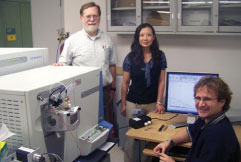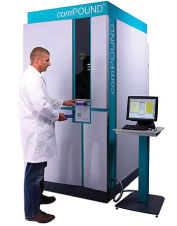Contents
- Funding Matters
HEI Grants Enable Cutting-Edge Research
Funding Matters
HEI Grants Enable Cutting-Edge Research

The Orbitrap XL Hybrid FT Mass Spectrometer System, purchased by Stony Brook University Medical Center with a High-End Instrumentation award, accurately measures the mass of individual molecules, helping researchers discover and characterize proteins and novel diagnostic biomarkers for major diseases. Pictured are Charles R. Iden, standing, scientific director of the Mass Spectrometer Facility and Proteomics Center; Researcher Emily Chen, assistant professor, Department of Pharmacological Sciences; and Toni Koller, technical director, Proteomics Center.
Scientists working toward personalized medicine envision a day when patients' entire genomes are part of their medical records, and physicians can receive alerts for gene variants associated with diseases and common or rare drug-linked side effects. Computer databases could help doctors find patients at highest risk for these diseases and side effects as well as those most likely to benefit from a particular treatment. Before that future can arrive, researchers have to find and understand the genotype-phenotype associations, and they need the resources to do it.
Through a recently funded NCRR High-End Instrumentation (HEI) award to Vanderbilt University, scientists can look forward to accessing such a resource. HEI awards enable the purchase of state-of-the-art research equipment by providing $750,000 to $2 million in direct costs for these advanced instruments, which can have an extraordinary impact on a wide variety of biomedical research in many disease areas.
At the Vanderbilt Institute for Clinical and Translational Research, the HEI award will enable the university to automate its DNA specimen and databank repository with a robotics system that handles the storage, maintenance, and distribution of DNA samples. The DNA Databank, which is a core resource for the institute, will store hundreds of thousands of DNA samples linked with clinical information from electronic medical records that do not include identifying information. By using this databank, researchers will be able to make and test discoveries not just in a carefully controlled laboratory environment but also in the real world, with samples and data from patients in clinical settings. The new robotics system will dramatically accelerate the rate at which translational researchers can access this resource. Thus it provides a vital first step in moving the emerging sciences of genomics and pharmacogenomics from the research lab to clinical practice, a key function of the Vanderbilt Institute for Clinical and Translational Research.

With its High-End Instrumentation award, Vanderbilt University will purchase a high-capacity robotic system, similar to the one pictured above, to support the storage, maintenance, and distribution of DNA samples in the Vanderbilt DNA Resource Core.
"The DNA Databank is a platform to get genome science to the bedside," says Dan Roden, principal investigator for the HEI grant. "It is a platform for testing future-tense medicine. But if the resource was available today, and someone asked for 5,000 samples and 5,000 controls, it would take several weeks to prepare." In addition, each individual researcher would want a custom-tailored collection for his or her study, which means databank staff would have to create individual plates from the master collection. The more individual collections are created, the more room there is for error or contamination. With the new robotics system, sample preparation will take mere days, with little to no error. The new system will speed access to the DNA Databank and enable research on genetic variation, disease susceptibility, and drug response.
The new system typifies the work of the Clinical and Translational Science Award (CTSA) consortium, which includes Vanderbilt’s Institute in its membership. Led by NCRR, the CTSA consortium is working to reduce the time it takes for laboratory discoveries to become treatments for patients and to train the next generation of clinical and translational researchers. Vanderbilt’s HEI grant will serve both of these endeavors, accelerating a critical function of the institute in line with the CTSA goal of speeding the translation of discoveries from the laboratory to the clinic.
Three other institutions in the CTSA consortium also received HEI grants this year. Washington University in St. Louis is buying a high-field Fourier Transform mass spectrometer to examine protein structure and function, particularly the changes that occur after proteins are made. The new instrument will help researchers learn more about and find new treatments for arthritis, autoimmune disorders, cancer, diabetes, HIV infection, interstitial cystitis, and blood disorders.
The University of Pennsylvania is purchasing a cyclotron to make new radiotracers, which will enhance the molecular imaging research done at the CTSA-funded Institute for Translational Medicine and Therapeutics. The cyclotron will give researchers new ways of understanding biologic processes and diagnosing such diseases as cancer.
The Clinical and Translational Science Institute at the University of North Carolina at Chapel Hill will use its HEI award to replace its head-only magnetic resonance scanner with a new whole-body scanner with parallel processing. The new scanner will shorten the time needed to get high-quality images, and with enhancements supported by other university funds, the scanner will allow researchers to obtain magnetic resonance and positron emission tomography images at the same time. Thus the new scanner will facilitate a key component of the institute and greatly improve the ability to directly translate research imaging projects into the clinical arena.

Indiana University received a High-End Instrumentation award to purchase a high-throughput confocal imaging system for rapidly screening large numbers of fluorescently labeled live cell samples. This equipment will aid in the potential development of new cancer and antibiotic therapies. The image above, created with this equipment, shows HeLa cells, a certain type of cell used in medical research. The cells are expressing two molecules called green fluorescent protein and mCherry fluorescent protein, which are used to mark such cell structures as kinetochores (green), spindle poles (green), and chromosomes (red).
This year, NCRR awarded 20 HEI grants to 18 institutions. This round of grants, which total more than $33 million, will help awardees buy specialized equipment, such as nuclear magnetic resonance spectrometers, high-powered electron microscopes, biomedical imagers, high-resolution mass spectrometers, supercomputers that rapidly process vast amounts of data, and cyclotrons that produce new probes for noninvasive molecular imaging. In synergy with the aims of the CTSA program and other NIH initiatives, HEI grants for this type of equipment open up new avenues in biomedical research, leading to further understanding of normal biology and new advances and treatments for various diseases.
—Frances McFarland Horne
The High-End Instrumentation (HEI) Grant Program
Since it began in 2002, the HEI program has provided more than $187 million in 120 awards across 26 states. The awards are one-year, non-renewable grants that support $750,000 to $2 million in direct costs for a single major item of advanced equipment. They allow the purchase of equipment that is too costly for NCRR's Shared Instrumentation Grant program.
"HEI grants support the purchase of a new generation of instruments, making possible research that could not be accomplished before and speeding translation of new discoveries to the clinic," says Marjorie Tingle, director of the HEI grant program. "These grants enable breakthroughs and keep researchers at the forefront of modern biology and medicine."
Priority for using instruments supported by HEI grants should be given to NIH-supported scientists engaged in biomedical and behavioral research. HEI awardees also must provide the infrastructure needed to support the new equipment. More information about the HEI program



